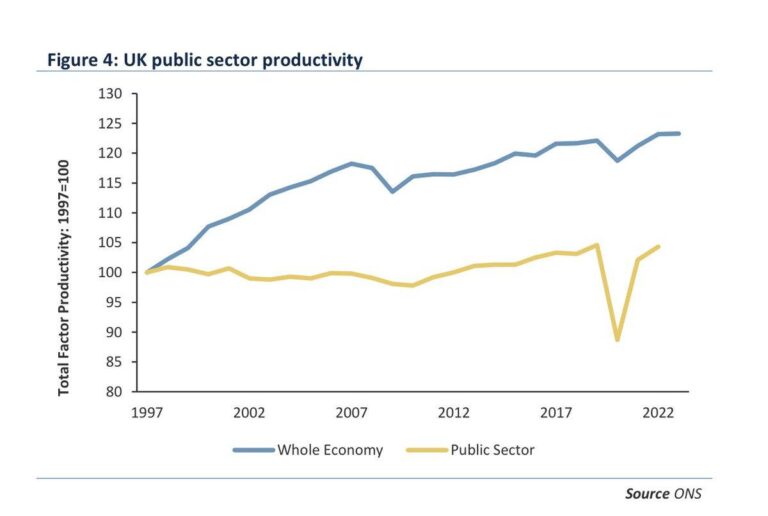The productivity of the UK public sector has shown signs of improvement in recent months, according to new government data, signaling a cautious recovery as the country emerges from the pandemic’s economic disruptions. However, despite this uptick, output levels remain below those recorded before COVID-19 struck, highlighting ongoing challenges facing public services amid rising demand and budgetary pressures. The latest figures underscore the delicate balance policymakers must navigate to restore efficiency while addressing the evolving needs of the population.
UK Public Sector Productivity Shows Signs of Recovery Amid Ongoing Challenges
Recent data highlights a modest rebound in the UK’s public sector productivity, signaling resilience amid ongoing economic and operational hurdles. After a steep decline following the onset of the COVID-19 pandemic, government departments and agencies have gradually adapted to new working models, investing in digital tools and streamlining processes. These efforts have helped to partially close the productivity gap; however, output remains below pre-pandemic levels, reflecting continued pressures from workforce shortages, evolving public demands, and constrained budgets.
Key factors influencing current productivity trends include:
- Increased adoption of remote and hybrid working arrangements
- Ongoing investments in technology modernization
- The challenge of balancing service quality with cost-efficiency
- Recruitment and retention difficulties in critical public sector roles
| Period | Productivity Index (2019 = 100) | Output Growth (%) |
|---|---|---|
| Q1 2019 | 100 | 2.1 |
| Q2 2020 | 85 | -7.5 |
| Q4 2023 | 92 | 3.8 |
Impact of Remote Work and Technology Integration on Efficiency Gains
Over the past year, remote work has fundamentally altered traditional workflows within the UK public sector, serving as both a catalyst and a challenge in equal measure. While digital collaboration tools and cloud infrastructure have accelerated communication and project management, the lack of physical interaction still poses issues for coordination in complex tasks. Notably, many departments report increased flexibility allowing staff to better balance workloads, but gaps in training and technology adoption continue to limit the full potential of these gains.
- Flexible working hours have reduced downtime and boosted focus for many employees.
- Integration of AI-driven analytics tools aids in streamlining administrative duties.
- Security concerns with remote setups require ongoing investment and policy updates.
Quantifying these shifts, a recent internal survey showcased measurable improvements in output alongside persistent hurdles. The following table summarizes key productivity metrics before and after the widespread remote work implementation:
| Metric | Pre-Pandemic | Mid-Pandemic | Post-Adoption |
|---|---|---|---|
| Average Task Completion Time | 5.2 days | 6.5 days | 5.8 days |
| Collaboration Efficiency | 80% | 65% | 75% |
| Employee Satisfaction | 72% | 68% | 78% |
Strategies for Sustained Growth to Restore Pre-Pandemic Productivity Levels
To rebuild momentum in the UK public sector, a targeted focus on enhancing digital infrastructure and workforce flexibility is essential. Investing in cloud technologies, AI-powered analytics, and secure remote working platforms can radically improve service delivery and reduce bottlenecks. Equally important is fostering a culture of continuous learning, enabling employees to acquire new skills and adapt quickly to evolving demands. Public bodies embracing hybrid working models have reported better employee satisfaction and efficiency, suggesting that flexible arrangements remain a key driver in restoring productivity.
Strategic initiatives include:
- Upskilling and reskilling programs tailored to emerging public service needs
- Implementation of performance management systems that emphasize outcomes over hours
- Streamlining bureaucratic processes to eliminate redundancies and speed decision-making
- Incentivizing innovation through pilot projects and cross-department collaborations
| Strategy | Expected Outcome | Timeframe |
|---|---|---|
| Digital Transformation | 25% Faster Service Delivery | 12 Months |
| Hybrid Work Models | 15% Productivity Gain | 6 Months |
| Reskilling Initiatives | 30% Employee Skill Improvement | 18 Months |
Key Takeaways
As the UK public sector begins to regain momentum in productivity, the road to pre-pandemic levels remains a work in progress. While recent data signals a cautious improvement, policymakers and stakeholders continue to grapple with lingering challenges that have constrained efficiency across various public services. The evolving landscape will require sustained efforts to boost output and address structural hurdles, ensuring that the sector can meet the demands of a post-pandemic Britain. Reuters will continue monitoring these developments as they unfold.




